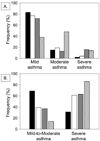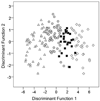Heterogeneity of severe asthma in childhood: confirmation by cluster analysis of children in the National Institutes of Health/National Heart, Lung, and Blood Institute Severe Asthma Research Program
- PMID: 21195471
- PMCID: PMC3060668
- DOI: 10.1016/j.jaci.2010.11.015
Heterogeneity of severe asthma in childhood: confirmation by cluster analysis of children in the National Institutes of Health/National Heart, Lung, and Blood Institute Severe Asthma Research Program
Abstract
Background: Asthma in children is a heterogeneous disorder with many phenotypes. Although unsupervised cluster analysis is a useful tool for identifying phenotypes, it has not been applied to school-age children with persistent asthma across a wide range of severities.
Objectives: This study determined how children with severe asthma are distributed across a cluster analysis and how well these clusters conform to current definitions of asthma severity.
Methods: Cluster analysis was applied to 12 continuous and composite variables from 161 children at 5 centers enrolled in the Severe Asthma Research Program.
Results: Four clusters of asthma were identified. Children in cluster 1 (n = 48) had relatively normal lung function and less atopy. Children in cluster 2 (n = 52) had slightly lower lung function, more atopy, and increased symptoms and medication use. Cluster 3 (n = 32) had greater comorbidity, increased bronchial responsiveness, and lower lung function. Cluster 4 (n = 29) had the lowest lung function and the greatest symptoms and medication use. Predictors of cluster assignment were asthma duration, the number of asthma controller medications, and baseline lung function. Children with severe asthma were present in all clusters, and no cluster corresponded to definitions of asthma severity provided in asthma treatment guidelines.
Conclusion: Severe asthma in children is highly heterogeneous. Unique phenotypic clusters previously identified in adults can also be identified in children, but with important differences. Larger validation and longitudinal studies are needed to determine the baseline and predictive validity of these phenotypic clusters in the larger clinical setting.
Copyright © 2011 American Academy of Allergy, Asthma & Immunology. Published by Mosby, Inc. All rights reserved.
Figures


References
-
- Long-term effects of budesonide or nedocromil in children with asthma. The Childhood Asthma Management Program Research Group. N Engl J Med. 2000;343:1054–1063. - PubMed
-
- Expert Panel Report 3 (EPR-3): Guidelines for the Diagnosis and Management of Asthma-Summary Report 2007. J Allergy Clin Immunol. 2007;120:S94–S138. - PubMed
Publication types
MeSH terms
Grants and funding
- KL2 TR000455/TR/NCATS NIH HHS/United States
- R01 HL069174/HL/NHLBI NIH HHS/United States
- G1000758/MRC_/Medical Research Council/United Kingdom
- UL1 RR024992/RR/NCRR NIH HHS/United States
- U10 HL109250/HL/NHLBI NIH HHS/United States
- KL2 RR025009/RR/NCRR NIH HHS/United States
- TL1 TR000456/TR/NCATS NIH HHS/United States
- UL1 TR000454/TR/NCATS NIH HHS/United States
- U10 HL109164/HL/NHLBI NIH HHS/United States
- R01 HL069167/HL/NHLBI NIH HHS/United States
- R01 HL091762/HL/NHLBI NIH HHS/United States
- UL1 TR000005/TR/NCATS NIH HHS/United States
- TL1 RR025010/RR/NCRR NIH HHS/United States
- R01 HL069149/HL/NHLBI NIH HHS/United States
- R01 HL069170/HL/NHLBI NIH HHS/United States
- R01 HL69149/HL/NHLBI NIH HHS/United States
- UL1 RR025008/RR/NCRR NIH HHS/United States
LinkOut - more resources
Full Text Sources
Other Literature Sources
Medical
Molecular Biology Databases

